A Universal Biofilm Reactor Sensor for the Determination of Biochemical Oxygen Demand of Different Water Areas
Abstract
:1. Introduction
2. Experimental
2.1. Material and Sample Preparation
2.2. Preparation of Biofilm Reactor
2.3. Measurement Procedure
3. Results and Discussion
3.1. Performance Optimization
3.1.1. The Influence of Temperature
3.1.2. The Influence of Flow Rate
3.1.3. Salt Tolerance of the BFR Sensor
3.1.4. Stability of the BFR Sensor
3.2. Activity and Application of the BFR Sensor
3.2.1. Degradation Ability for Different Organics
3.2.2. Standard Curve of the BFR Sensor
3.2.3. Application of BFR Sensor
3.3. Analysis of Microbial Community Structure
4. Conclusions
Supplementary Materials
Author Contributions
Funding
Institutional Review Board Statement
Informed Consent Statement
Data Availability Statement
Conflicts of Interest
Sample Availability
References
- Available online: http://en.volupedia.org/wiki/Biochemical_oxygen_demand (accessed on 17 February 2022).
- Rice, E.W.; Baird, R.B.; Eaton, A.D. Standard Methods for the Examination of Water, 23rd ed.; American Public Health Association: Washington, DC, USA; American Water Works Association: Denver, CO, USA; Water Environment Federation: Alexandria, VA, USA, 2017. [Google Scholar]
- Karube, I.; Matsunaga, T.; Mitsuda, S.; Suzuk, S. Microbial electrode BOD sensors. Biotechnol. Bioeng. 1977, 19, 1535–1547. [Google Scholar] [CrossRef] [PubMed]
- Kharkova, A.S.; Arlyapov, V.A.; Ilyukhina, A.S.; Ponamoreva, O.N.; Alferov, V.A.; Reshetilov, A.N. A kinetic approach to the formation of two-mediator systems for developing microbial biosensors as exemplified by a rapid biochemical oxygen demand assay. Biotechnology 2021, 11, 222. [Google Scholar] [CrossRef] [PubMed]
- Sonawane, J.M.; Ezugwu, C.I.; Ghosh, P.C. Microbial fuel cell-based biological oxygen demand sensors for monitoring wastewater: State-of-the-art and practical applications. ACS Sens. 2020, 5, 2297–2316. [Google Scholar] [CrossRef]
- Gao, Y.Y.; Yin, F.J.; Ma, W.Q.; Wang, S.; Liu, Y.; Liu, H. Rapid detection of biodegradable organic matter in polluted water with microbial fuel cell sensor: Method of partial coulombic yield. Bioelectrochemistry 2020, 133, 107488. [Google Scholar] [CrossRef] [PubMed]
- Sevda, S.; Garlapati, V.K.; Naha, S.; Sharma, M.; Ray, S.G.; Sreekrishnan, T.R.; Goswami, P. Biosensing capabilities of bioelectrochemical systems towards sustainable water streams: Technological implications and future prospects. J. Biosci. Bioeng. 2020, 129, 647–656. [Google Scholar] [CrossRef] [PubMed]
- Gorski, L.; Trzebuniak, K.F.; Malinowska, E. Low BOD determination methods: The state-of-the-art. Chem. Process Eng. 2012, 33, 629–637. [Google Scholar] [CrossRef]
- Nakamura, H.; Suzuki, K.; Ishikuro, H.; Kinoshita, S.; Koizumi, R.; Okuma, S.; Gotoh, M.; Karube, I. A new BOD estimation method employing a double-mediator system by ferricyanide and menadione using the eukaryote Saccharomyces cerevisiae. Talanta 2007, 72, 210–216. [Google Scholar] [CrossRef]
- Martin, M.J.; Burguillo, F.J.; Bardsley, W.G. Modelling the simultaneous processes occurring during the BOD5 test using synthetic waters as a pattern. Bioprocess Biosyst. Eng. 2009, 32, 207–216. [Google Scholar] [CrossRef]
- Bonetto, M.C.; Sacco, N.J.; Ohlsson, A.H.; Corton, E. Metabolism of Klebsiella pneumoniae freeze-dried cultures for the design of BOD bioassays. Lett. Appl. Microbiol. 2012, 55, 370–375. [Google Scholar] [CrossRef]
- Liu, J.; Mattiasson, B. Microbial BOD sensors for wastewater analysis. Water Res. 2002, 36, 3786–3802. [Google Scholar] [CrossRef]
- Jiang, Y.; Yang, X.F.; Liang, P.; Liu, P.P.; Huang, X. Microbial fuel cell sensors for water quality early warning systems: Fundamentals, signal resolution, optimization and future challenges. Renew. Sustain. Energy Rev. 2018, 81, 292–305. [Google Scholar] [CrossRef]
- Jia, J.B.; Tang, M.Y.; Chen, X.; Qi, L.; Dong, S.J. Co-immobilized microbial biosensor for BOD estimation based on sol-gel derived composite material. Biosens. Bioelectron. 2003, 18, 1023–1029. [Google Scholar] [CrossRef]
- Lin, L.; Xiao, L.L.; Huang, S.; Zhao, L.; Cui, J.S.; Wang, X.H.; Chen, X. Novel BOD optical fiber biosensor based on co-immobilized microorganisms in ormosils matrix. Biosens. Bioelectron. 2006, 21, 1703–1709. [Google Scholar] [CrossRef]
- Wang, X.H.; Chen, Y.; Yuan, B.; Li, X.F.; Ren, Y.P. Impacts of sludge retention time on sludge characteristics and membrane fouling in a submerged osmotic membrane bioreactor. Bioresour. Technol. 2014, 161, 340–347. [Google Scholar] [CrossRef]
- Frank, V.B.; Regnery, J.; Chan, K.E.; Ramey, D.F.; Spear, J.R.; Cath, T.Y. Co-treatment of residential and oil and gas production wastewater with a hybrid sequencing batch reactor-membrane bioreactor process. J. Water Process Eng. 2017, 17, 82–94. [Google Scholar] [CrossRef]
- Mutlu, B.K.; Ozgun, H.; Ersahin, M.E.; Kaya, R.; Eliduzgun, S.; Altinbas, M.; Kinaci, C.; Koyuncu, I. Impact of salinity on the population dynamics of microorganisms in a membrane bioreactor treating produced water. Sci. Total Environ. 2019, 646, 1080–1089. [Google Scholar] [CrossRef]
- Lv, H.; Yang, Q.; Chen, Y.L.; Xu, X.L.; Liu, C.Y.; Jia, J.B. Determination of seawater biochemical oxygen demand based on in situ cultured biofilm reactor. J. Electroanal. Chem. 2021, 903, 115872. [Google Scholar] [CrossRef]
- Liu, C.Y.; Li, Z.; Jiang, D.; Jia, J.B.; Zhang, Y.; Chai, Y.; Cheng, X.D.; Dong, S.J. Demonstration study of biofilm reactor based rapid biochemical oxygen demand determination of surface water. Sens. Bio-Sens. Res. 2016, 8, 8–13. [Google Scholar] [CrossRef] [Green Version]
- Liu, C.Y.; Zhao, H.J.; Gao, S.; Jia, J.B.; Zhao, L.M.; Yong, D.M.; Dong, S.J. A reagent-free tubular biofilm reactor for on-line determination of biochemical oxygen demand. Biosens. Bioelectron. 2013, 45, 213–218. [Google Scholar] [CrossRef]
- Liu, C.Y.; Jia, J.B.; Dong, S.J. Biofilm reactor based real-time analysis of biochemical oxygen demand. Biosens. Bioelectron. 2013, 42, 1–4. [Google Scholar] [CrossRef]
- Liu, C.Y.; Zhao, H.J.; Zhong, L.J.; Liu, C.; Jia, J.B.; Xu, X.L.; Liu, L.; Dong, S.J. A biofilm reactor-based approach for rapid on-line determination of biodegradable organic pollutants. Biosens. Bioelectron. 2012, 34, 77–82. [Google Scholar] [CrossRef]
- Liu, C.Y.; Ma, C.; Yu, D.B.; Jia, J.B.; Liu, L.; Zhang, B.L.; Dong, S.J. Immobilized multi-species based biosensor for rapid biochemical oxygen demand measurement. Biosens. Bioelectron. 2010, 26, 2074–2079. [Google Scholar] [CrossRef]
- Liu, C.Y.; Dong, S.J. Field application of a biofilm reactor based BOD prototype in Taihu Lake, China. Talanta 2013, 109, 147–151. [Google Scholar] [CrossRef]
- Tan, T.C.; Lim, E.W.C. Thermally killed cells of complex microbial culture for biosensor measurement of BOD of wastewater. Sen. Actuators B Chem. 2005, 107, 546–551. [Google Scholar] [CrossRef]
- Pang, H.L.; Kwok, N.Y.; Chan, P.H.; Yeung, C.H.; Lo, W.H.; Wong, K.Y. High-throughput determination of biochemical oxygen demand (BOD) by a microplate-based biosensor. Environ. Sci. Technol. 2007, 11, 4038–4044. [Google Scholar] [CrossRef]
- Reid, E.; Liu, X.; Judd, S.J. Effect of high salinity on activated sludge characteristics and membrane permeability in an immersed membrane bioreactor. J. Membr. Sci. 2006, 283, 164–171. [Google Scholar] [CrossRef]
- Liu, J.; Bjornsson, L.; Mattiasson, L. Immobilised activated sludge based biosensor for biochemical oxygen demand measurement. Biosens. Bioelectron. 2000, 14, 883–893. [Google Scholar] [CrossRef]
- Morris, K.; Catterall, K.; Zhao, H.J.; Pasco, N.; John, R. Ferricyanide mediated biochemical oxygen demand—Development of a rapid biochemical oxygen demand assay. Anal. Chim. Acta 2001, 442, 129–139. [Google Scholar] [CrossRef]
- Kozich, J.J.; Westcott, S.L.; Baxter, N.T.; Highlander, S.K.; Schloss, P.D. Development of a dual-Index sequencing strategy and curation pipeline for analyzing amplicon sequence data on the MiSeq Illumina sequencing platform. Environ. Microbiol. 2013, 79, 5112–5120. [Google Scholar] [CrossRef] [PubMed] [Green Version]
- Nimnoi, P.; Pongsilp, N. Marine bacterial communities in the upper gulf of Thailand assessed by Illumina next-generation sequencing platform. BMC Microbiol. 2020, 20, 19–21. [Google Scholar] [CrossRef] [Green Version]
- Chen, J. Environmental Engineering Microbiology; Wuhan University of Technology Press: Wuhan, China, 2003; pp. 21–23. [Google Scholar]
- Mayara, F.; Marco, S. Description of a new Brazilian species of Mycodrosophila (Diptera, Drosophilidae) with emphasis on the morphology of phallic sclerites. Rev. Bras. Entomol. 2019, 63, 250–253. [Google Scholar]
- Nakahara, N.; Takaki, Y.; Ogawara, M.; Yamaguchi, T.; Takai, K.; KiImachi, H. Complete genome sequence of Pelolinea submarina MO-CFX1T within the phylum Chloroflexi, isolated from subseafloor sediment. Mar. Genom. 2019, 46, 49–53. [Google Scholar] [CrossRef]
- Katalin, S.; Beata, M. Chlorophylls and their derivatives used in food industry and medicine. Methods Mol. Biol. 2017, 17, 1194–1222. [Google Scholar]
- Schmid, M.; Risgaard-Petersen, N.; Van, D. Anaerobic ammonium-oxidizing bacteria in marine environments: Widespread occurrence but low diversity. Environ. Microbiol. 2007, 9, 1476–1484. [Google Scholar] [CrossRef]
- Zhou, T.Y.; Ni, Y.X.; Su, J.R. Diagnosis and Illustration of Clinical Microbiology; Shanghai Science and Technology Press: Shanghai, China, 2012; p. 306. [Google Scholar]
- Sheng, D.; Wang, Y.; Wu, S. The regulation of LexA on UV induced SOS response in Myxococcus xanthus based on transcriptome analysis. J. Microbiol. Biotechnol. 2021, 4, 2662. [Google Scholar] [CrossRef]
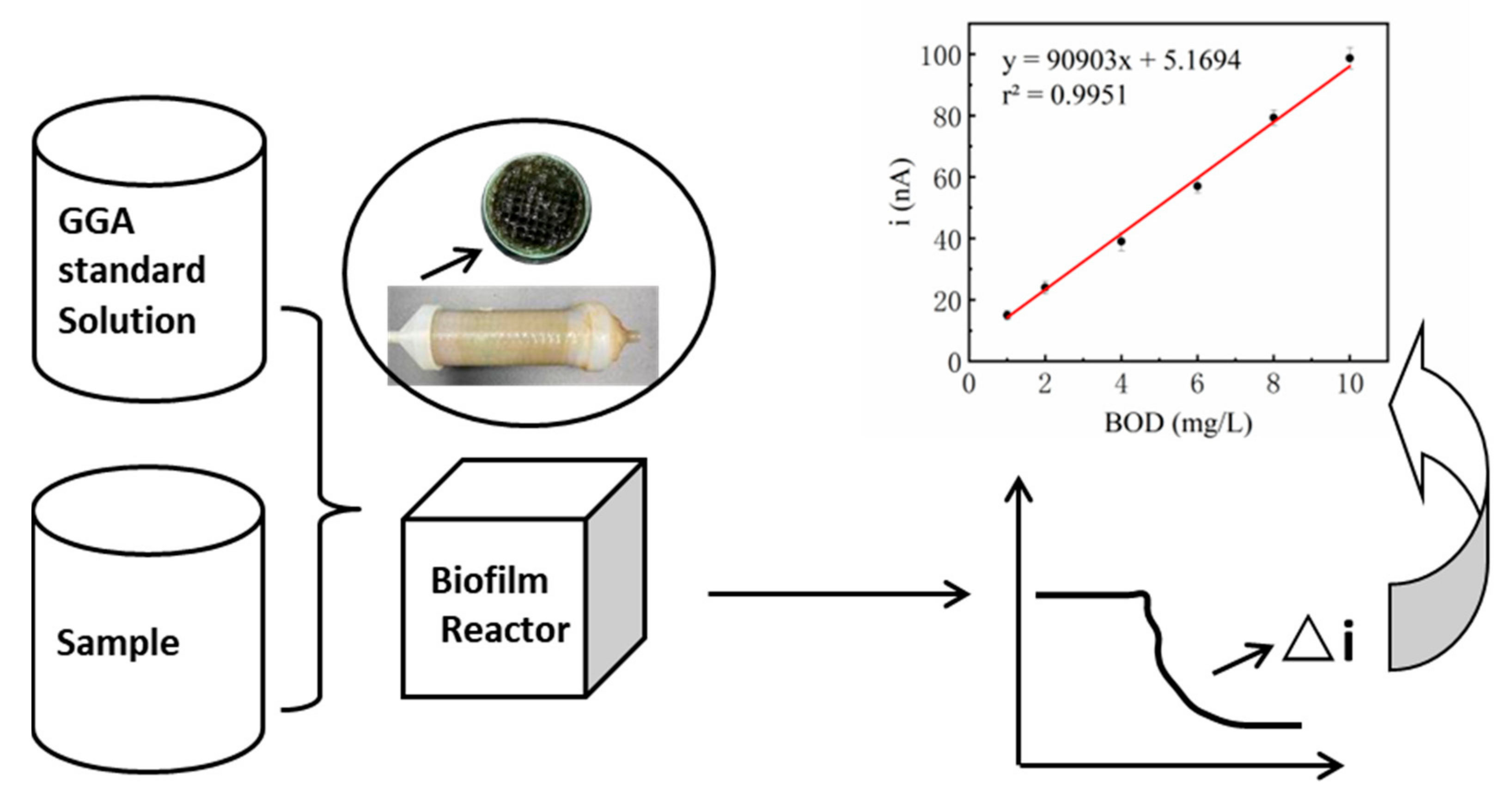
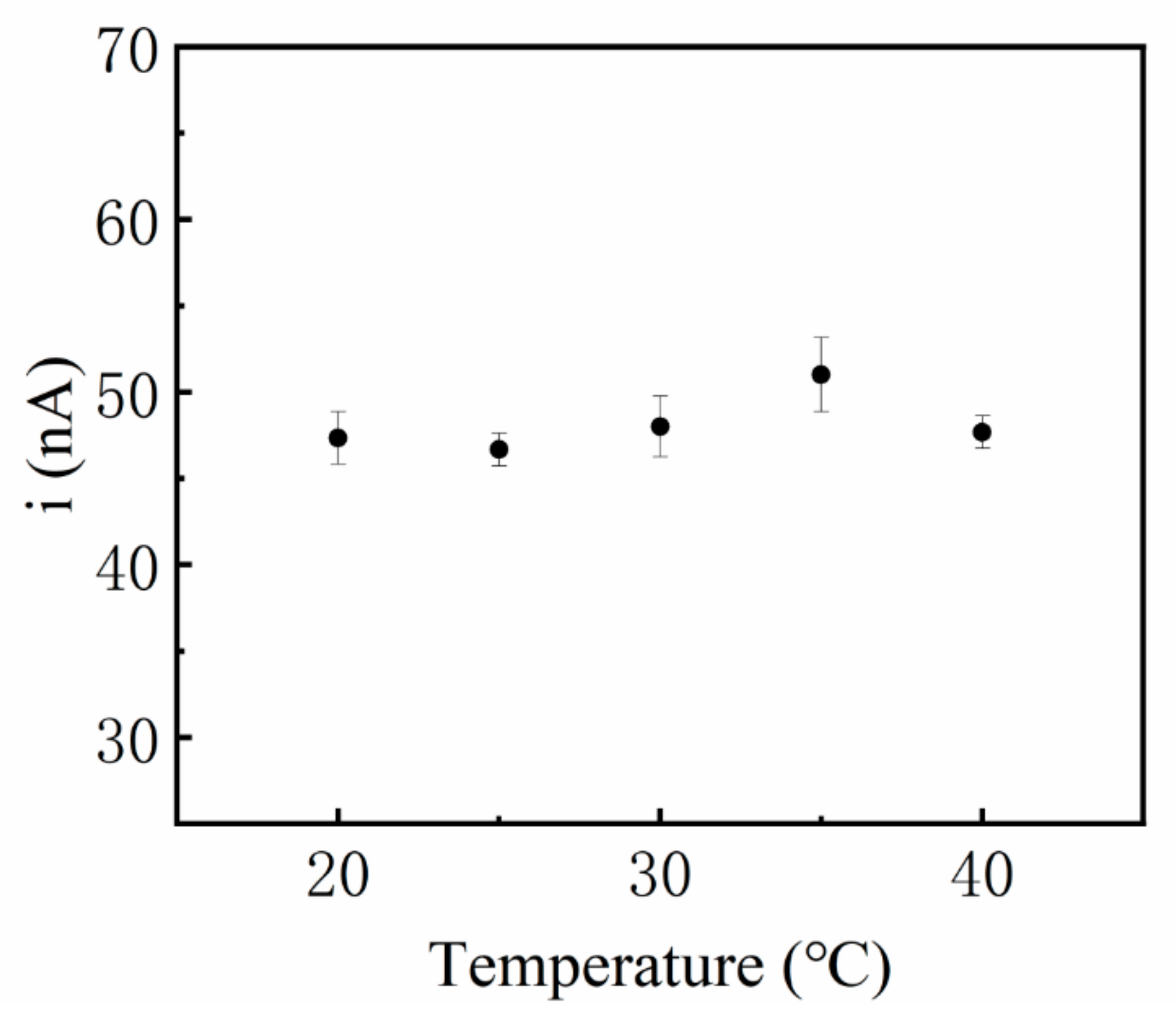
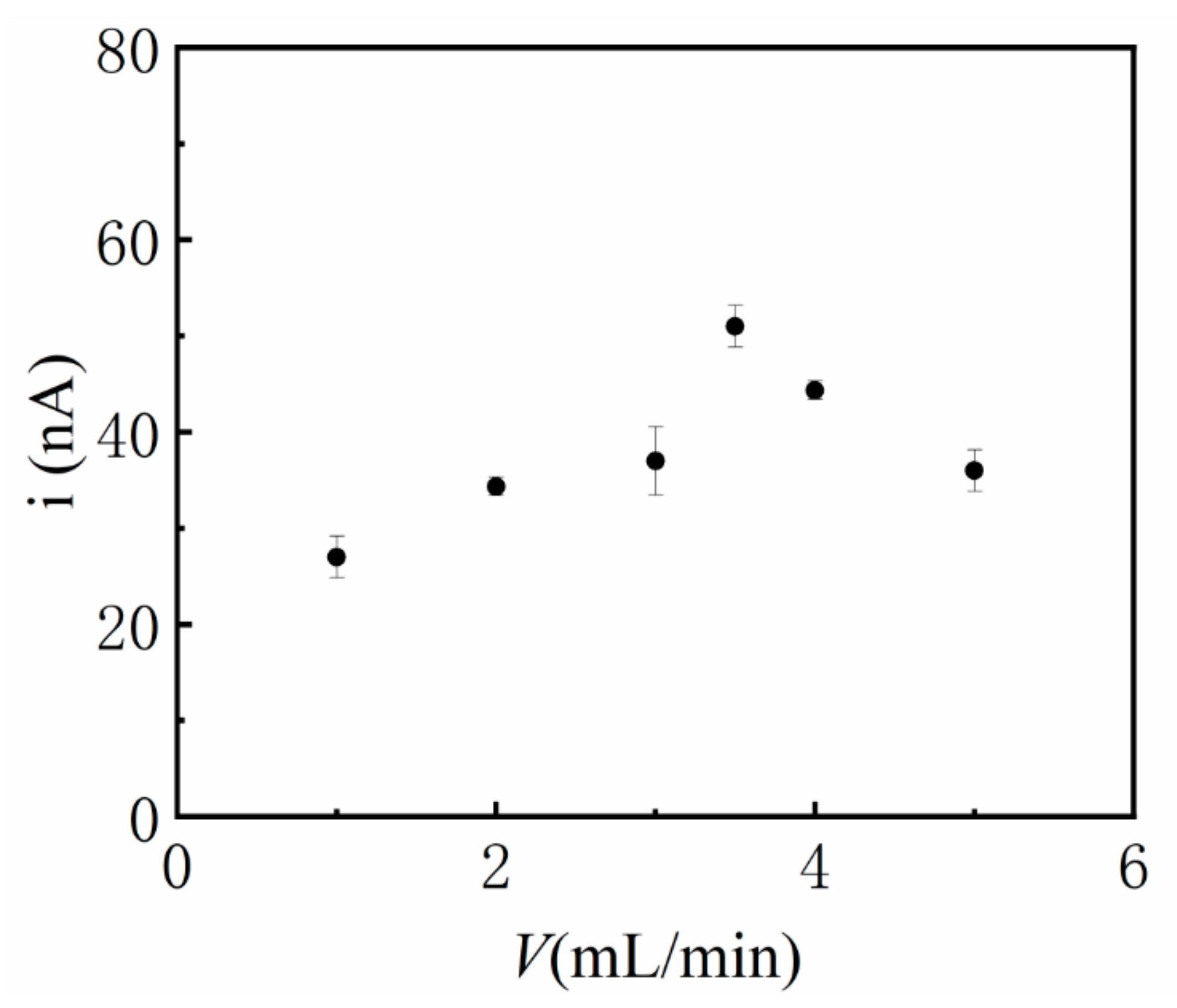
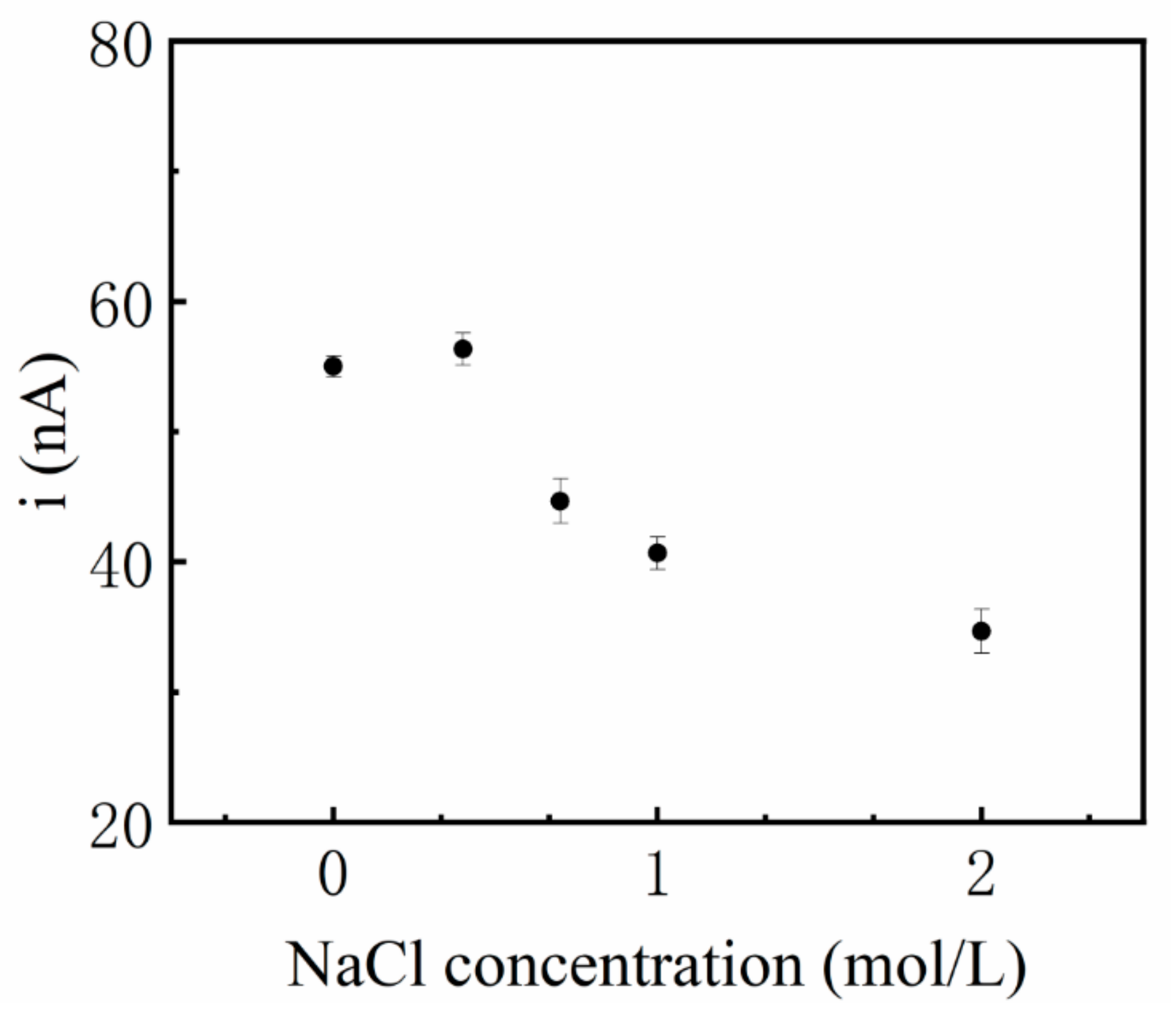
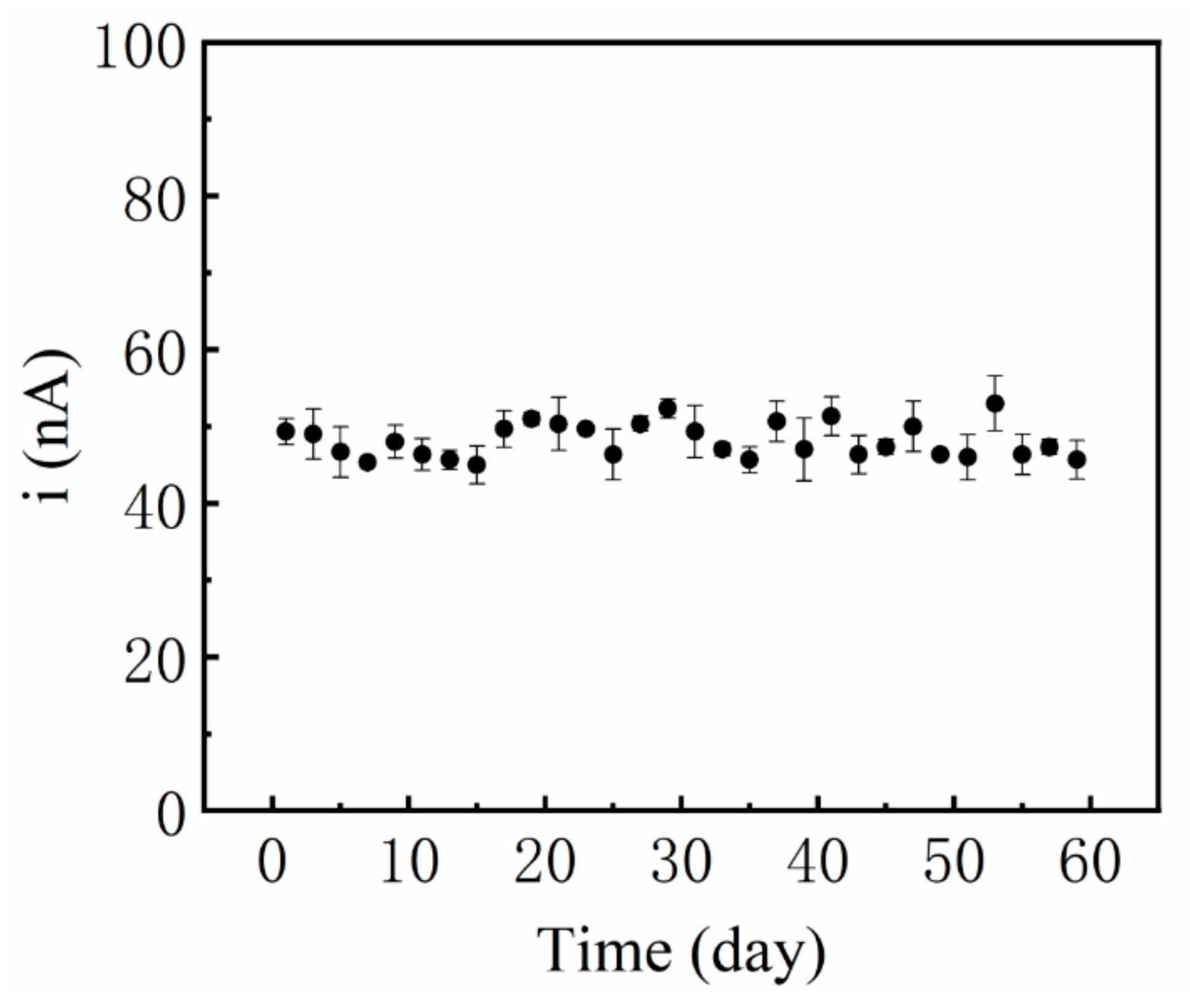
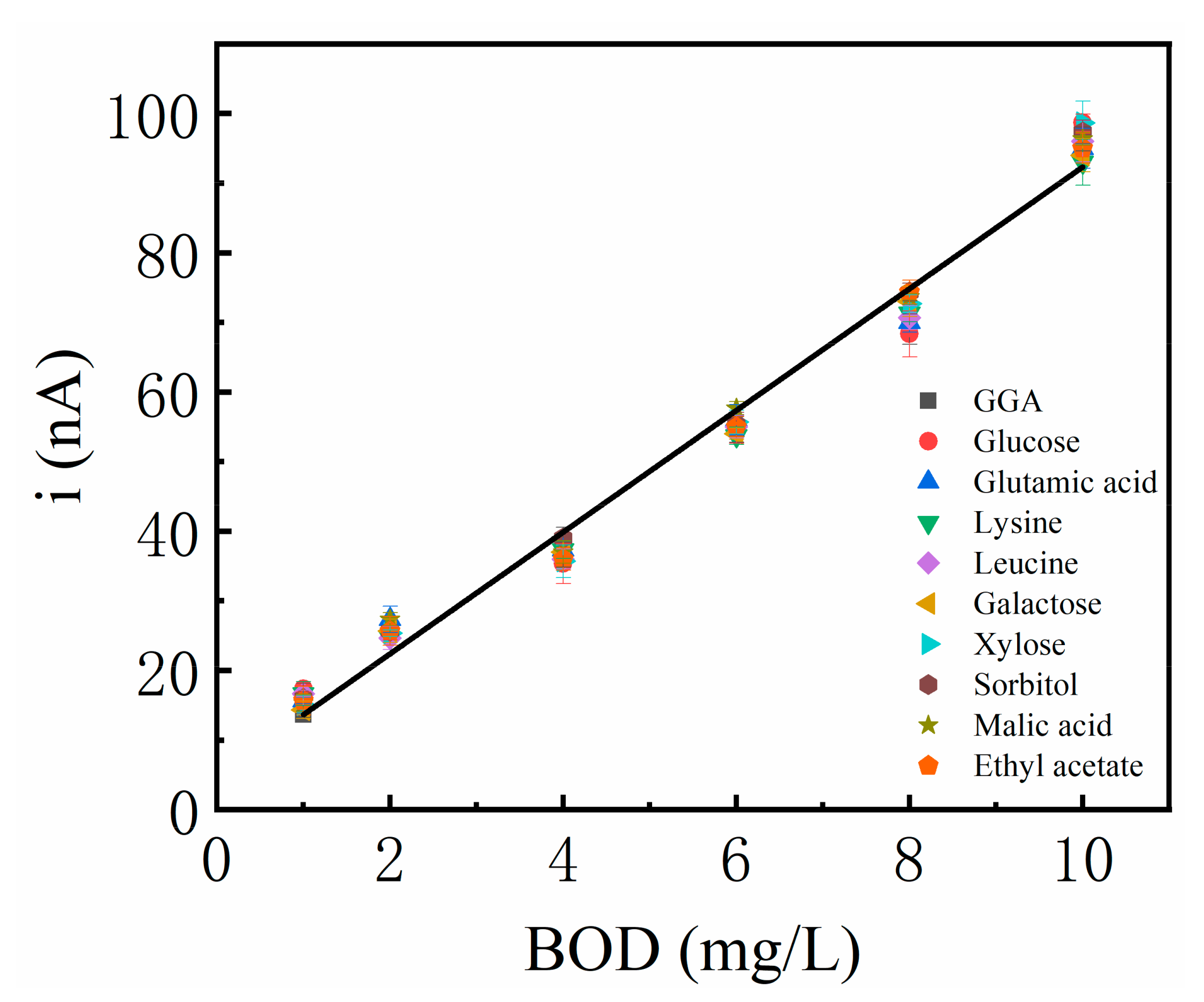
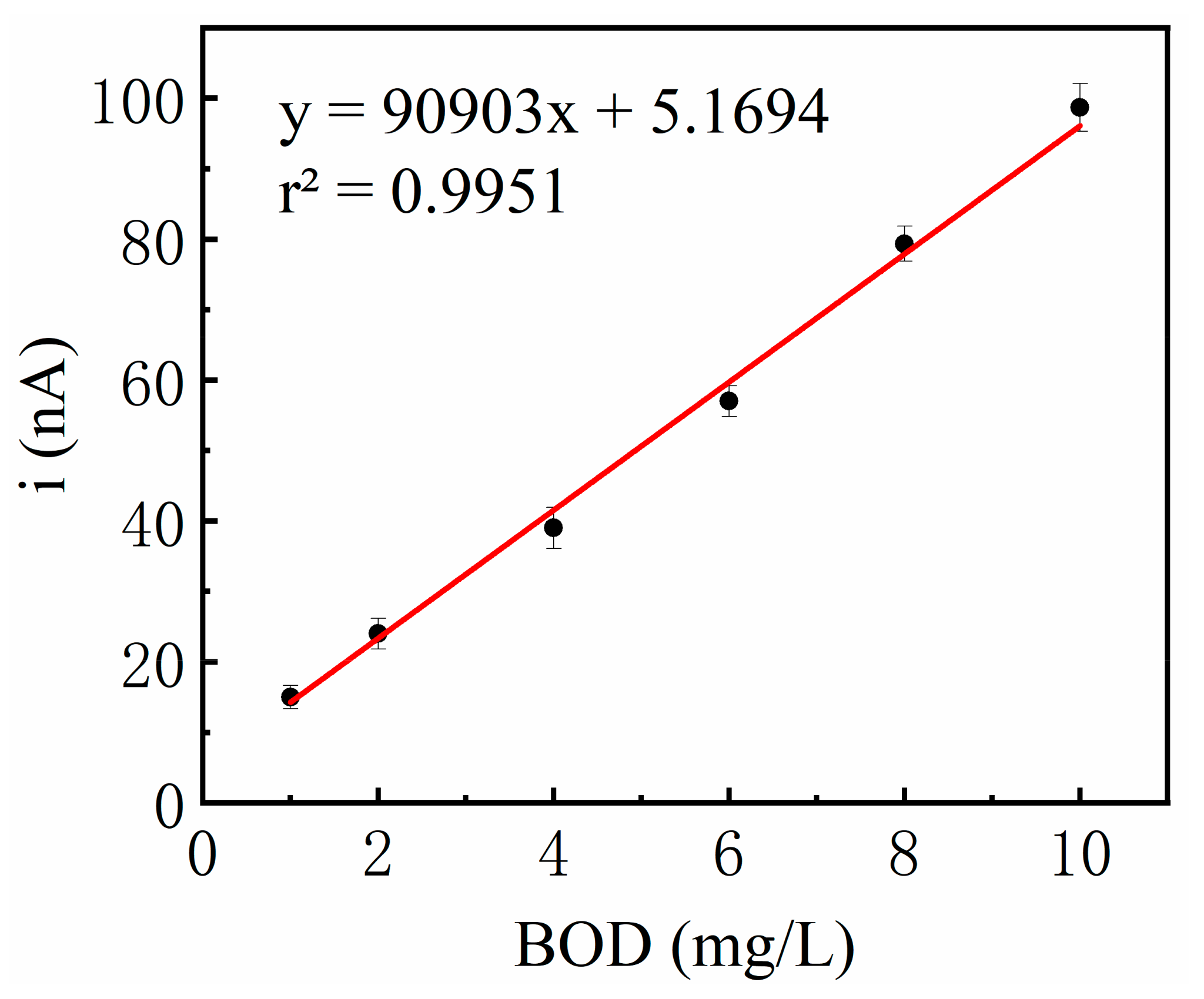
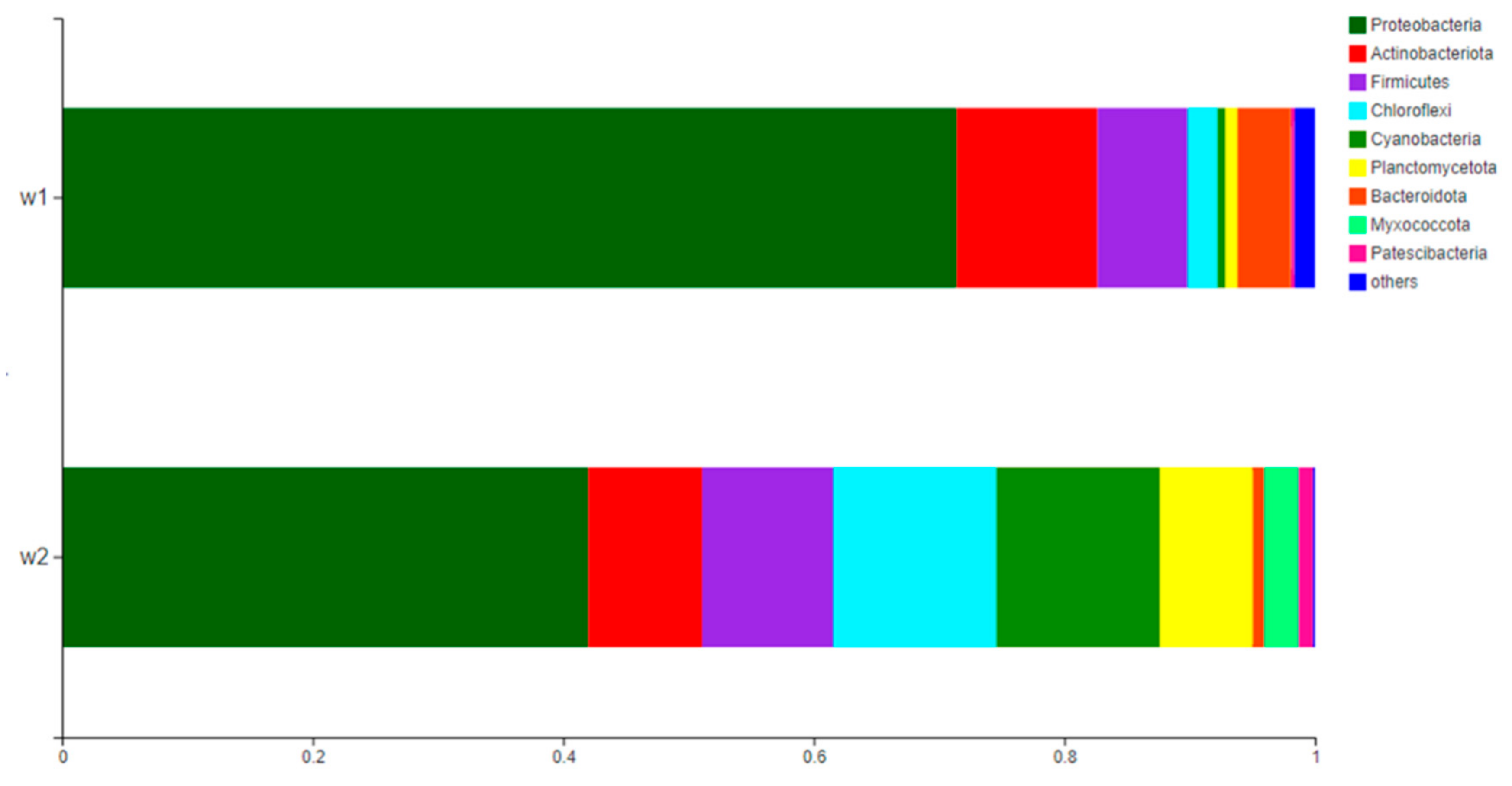
| Sample | BOD5 (mg/L) | BFR (mg/L) | Relative Error (%) |
|---|---|---|---|
| Xiachuan Island | 1.24 | 1.38 | 11.29 |
| Fenghuojiao | 1.45 | 1.62 | 12.41 |
| Sunshine beach | 1.07 | 1.21 | 13.08 |
| Tiansha River | 2.39 | 2.64 | 6.02 |
| Library Pond | 4.07 | 4.32 | 6.14 |
| Lotus Pond | 8.84 | 9.41 | 6.45 |
| Weiming Pond 1 | 30.69 | 33.50 | 9.16 |
| Microbial Species | Place | Scale | Trend | Characteristic |
|---|---|---|---|---|
| Proteobacteria | W1 | 71.41 | Down | Denitrification, treatment of industrial and agricultural wastewater, soil remediation, and degradation of complex pollution [32] |
| W2 | 42.01 | |||
| Actinobacteriota | W1 | 11.23 | Down | Degrade carbohydrates and complex compounds. Biological treatment of sewage [33] |
| W2 | 9.08 | |||
| Firmicutes | W1 | 7.2 | Up | It can survive well in dehydration and extreme environments [34] |
| W2 | 10.74 | |||
| Chloroflexi | W1 | 2.39 | Up | It can survive in extreme environments and degrade a large amount of organic matter [35] |
| W2 | 13.04 | |||
| Cyanobacteria | W1 | 0.62 | Up | It plays a positive role in sewage treatment and water purification, and can effectively remove chlorine and phosphorus [36] |
| W2 | 13.04 | |||
| Planctomycetota | W1 | 0.97 | Up | It is often found in sea water. Among them, anammox is an important strain in sewage treatment [37] |
| W2 | 7.41 | |||
| Bacteroidota | W1 | 4.23 | Down | It is the best carbohydrate degrading bacteria [38] |
| W2 | 0.93 | |||
| Myxococcota | W1 | 0.04 | Up | One of the most important pathogenic factors of human bacterial gastroenteritis [39] |
| W2 | 2.73 | |||
| Patescibacteria | HSW | 0.27 | Up | - |
| BFR | 1.15 | |||
| Others | W1 | 1.63 | Down | - |
Publisher’s Note: MDPI stays neutral with regard to jurisdictional claims in published maps and institutional affiliations. |
© 2022 by the authors. Licensee MDPI, Basel, Switzerland. This article is an open access article distributed under the terms and conditions of the Creative Commons Attribution (CC BY) license (https://creativecommons.org/licenses/by/4.0/).
Share and Cite
Wang, L.; Lv, H.; Yang, Q.; Chen, Y.; Wei, J.; Chen, Y.; Peng, C.; Liu, C.; Xu, X.; Jia, J. A Universal Biofilm Reactor Sensor for the Determination of Biochemical Oxygen Demand of Different Water Areas. Molecules 2022, 27, 5046. https://doi.org/10.3390/molecules27155046
Wang L, Lv H, Yang Q, Chen Y, Wei J, Chen Y, Peng C, Liu C, Xu X, Jia J. A Universal Biofilm Reactor Sensor for the Determination of Biochemical Oxygen Demand of Different Water Areas. Molecules. 2022; 27(15):5046. https://doi.org/10.3390/molecules27155046
Chicago/Turabian StyleWang, Liang, Huan Lv, Qian Yang, Yiliang Chen, Junjie Wei, Yiyuan Chen, Ci’en Peng, Changyu Liu, Xiaolong Xu, and Jianbo Jia. 2022. "A Universal Biofilm Reactor Sensor for the Determination of Biochemical Oxygen Demand of Different Water Areas" Molecules 27, no. 15: 5046. https://doi.org/10.3390/molecules27155046
APA StyleWang, L., Lv, H., Yang, Q., Chen, Y., Wei, J., Chen, Y., Peng, C., Liu, C., Xu, X., & Jia, J. (2022). A Universal Biofilm Reactor Sensor for the Determination of Biochemical Oxygen Demand of Different Water Areas. Molecules, 27(15), 5046. https://doi.org/10.3390/molecules27155046






